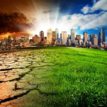Sustainable population growth and realities of climate change - Basic Storylines


By Nosike Uduezue
Teach your children what we have taught our children, that the earth is our mother, whatever befalls the earth befalls the sons of the earth — Chief Seattle of the Suquamish tribe to the United States president, Franklin Pierce in 1854.
CLIMATE change is caused by global warming. The simple meaning is that the temperatures we have today are higher than what we had previously. These higher temperatures are caused by green house gases which include carbon dioxide (CO2), methane (NH4), nitrous oxide (NO2), chlorofluorocarbon(CFC), etc.
These higher temperatures have given rise to changes in rainfall patterns, ice melting at the poles which has led to rise in sea levels, resulting in coastal flooding of low lying areas. Changes in rainfall patterns have resulted in some areas having limited rainfall, giving rise to draught and desertification whereas other areas now have excess rainfall, giving rise to flooding, flash flooding, river flooding.
Human population growth is a major contributor to global warming given that man exploits the earth resources for energy (fossil fuels), agriculture (land degradation, deforestation and use of pesticides, etc). More people will demand more energy, more food and more exploitation of the earth’s resources and more production of green house gases.
[ALSO READ] Don’t be a coward, defend yourself against bandits – Defence Minister tells Nigerians
According to the United Nations Population Fund, UNPF, human population grew from 1.6 billion to 6.1 billion people in the 20th century. It took 100 years for world population to hit 6.1 billion. During that period emission of carbon dioxide, the leading green house gas, grew 12-fold. With world-wide population expected to surpass nine billion over the next 50 years, environmentalists and others are worried about the ability of our planet to withstand the added load of green house gases entering the atmosphere and wreaking havoc on the ecosystems.
Several summits and protocols have been held on climate change and global warming. These include the Kyoto Protocol and Intergovernmental Panel on Climate Change, IPCC, UN Framework Convention on Climate Change, UNFCCC.
These mainly discuss how to reduce the production of green house gases; they have not actually emphasised population growth. A quick study will show that the developed countries who produce most of the green house gases have very low population growth rate. For instance, Asia accounts for 0.87 per cent, Africa: 2.49 per cent, Europe: 0.06 per cent and North America: 0.73 per cent.
This may be why population has not been seriously emphasied. However, developing nations like Nigeria with 2.6 per cent growth; Ethiopia, 2.4 per cent; Egypt, 1.8 per cent and Congo DR, 3.2 per cent must do something because apart from generating green house gases, they may be generating poverty with low GDP. But whereas population growth is stagnant or dropping in most developed countries (except USA due to migration), it is rising rapidly in quickly industrialising developing nations.
According to the United Nations Population Fund, UNPF, fast-growing developing countries like India and China will contribute more than half of global carbon dioxide emission by 2050 leading some to wonder if all the efforts being made to curb the US emission will be erased by other countries’ adoptions of the US long-held over-consumptive ways.
Human population growth is a major contributor to global warming. Man exploits the earths’ resources for energy (fossil fuels), agriculture and accommodation, (soil degradation and deforestation). In the case of deforestation the trees that could have utilized carbon dioxide in photosynthesis are cut down to make room for agriculture and building spaces.
[ALSO READ] TCN records partial power system collapse; Lagos, others in darkness
Population, global warming and consumption patterns are inextricably linked in their collective global environmental impact, reports the Global Population and Environment Programme, GPEP, at the non-profit Sierra Club. As developing countries’ contribution to global emission grows, population size and growth rates will become significant factors in magnifying the impact of global warming.
According to the Worldwatch Institute, a non-profit think-tank, the overriding challenges facing our global civilisation are to curtail climate change and slow down population growth. Success on these two fronts would make other challenges such as reversing the deforestation of the earth, stabilising water tables and protecting plant and animal diversity much more manageable, reports the group. If we cannot stabilise climate and we cannot stabilise population, there is not an ecosystem on Earth we can save.
Many population experts believe the answer lies in improving the health of women and children in developing nations. By reducing poverty and infant mortality, increasing women and girls access to basic human rights (health care, education, economic opportunities), educating women about birth control options and ensuring access to voluntary family planning services, women will choose to limit family sizes.
The post Sustainable population growth and realities of climate change appeared first on Vanguard News.
Comments
Post a Comment